by Melanie Taylor | May 22, 2015
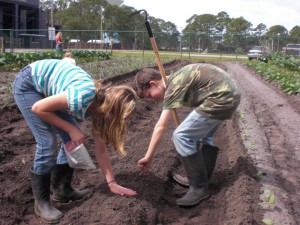
Planting Time
Did you know that something as simple as a garden can help youth not only learn to love vegetables, but also improve their science scores? Fifth-graders at Port St. Joe and Wewahitchka Elementary Schools experienced the benefits of gardening this year through the 4-H Seed to Plate Program. This program teaches youth how to plant, maintain, and harvest a vegetable garden, and is part of the science curriculum taught by 5th grade teachers.
Before the 130 students ever stepped foot in the garden they spent class time discussing the act of planting, the role that bees play in pollination and took a field trip to the North Florida Research and Education Center for 4-H Ag Adventures Day. This program is under the direction of Gulf County Extension Director Roy Lee Carter. The garden program is also supplemented with nutritional and food safety programs taught by Gulf County 4-H/Family & Consumer Science Agent, Melanie Taylor and Family Nutrition Program Assistant, Kay Freeman.
Carter said that the fifth grade is the ideal age level to learn gardening because the students are able to retain what they learn, and apply their new skills at home. The program is part of the science classes taught by the fifth-grade teachers each year. David and Sally Beyl have been volunteers with the program for the last seven years. Both are Master Gardeners who trained at the University of Florida for 12 weeks and contribute more than 50 hours of horticulture-related volunteer work each year.
“The students love it,” said David Beyl. “You can tell that they enjoy the experience.”
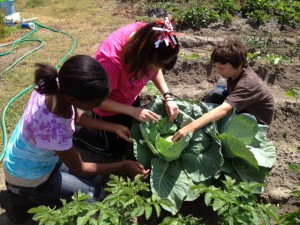
Harvest Time
A portion of what grows in the gardens was donated by Bonnie Plants in Alabama, the Florida Farm to School program, and the University of Florida’s Institute of Food and Agricultural Sciences. The Farm to School Partnership (administered by IFAS) works with local farmers to improve the supply of fresh produce to schools. Cabbage, lettuce, strawberries, potatoes, carrots, onions, eggplant, watermelon, beans, peppers, squash, sugarcane and various herbs made up this year’s garden with produce grown in-ground and in pots. “We use pots to show the students that even if you don’t have room for a garden, you can still have a garden,” Beyl said. In small groups, students learned how to plant seeds, rake, fertilize, cultivate, and harvest. Students even took home cabbages, carrots and potatoes to prepare and share with their families. Those who had an interest in starting their own gardens were given seeds to plant at home.
The highlight of the program is a luncheon prepared by cafeteria staff with produce grown by students. Everything the students munched on came from the garden they spent eight months cultivating. Both school principals are supportive and find this hands-on opportunity a great addition to the science program. This 4-H and public school collaboration is a very successful, educational and fun-filled learning experience.
If you have a green thumb, consider going “totally green” as a 4-H gardening volunteer or Master Gardener. 4-H needs caring adults like you to share their knowledge and passion for gardening with the next generation. Through the 4-H gardening project, youth not only learn gardening knowledge and skills, they also learn responsibility, teamwork, and other life skills that will help them grow up to be compassionate and competent citizens. To get involved, contact your local UF IFAS Extension Office, or visit http://florida4h.org./volunteers.
Your opinion matters! Please provide feedback on this short survey to help us improve our blog: https://ufl.qualtrics.com/SE/?SID=SV_3gtLKjqia3F75QN.
by pmdavis | Oct 25, 2013
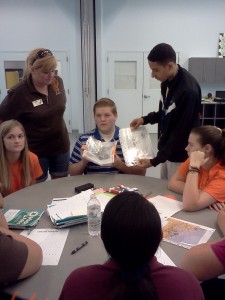
Looking at two different plans designed by group
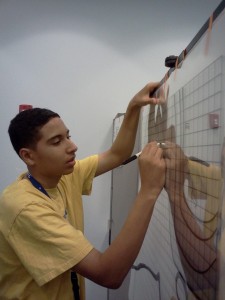
Drawing a map layer
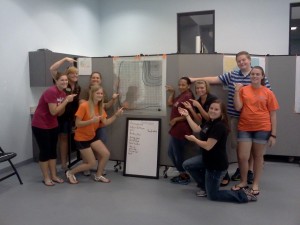
Teens and staff training to teach NYSD Material
October 6-12 was National 4-H Week, and more than 6 million young people across the country celebrated the great things that the 4-H youth development program offers young people and the incredible 4-H’ers who work each day to a make a positive impact on their community.
One of the highlights of National 4-H Week has become the 4-H National Youth Science Day (NYSD). For more than 100 years, 4-H has been at the forefront of teaching young people about science, technology, engineering and math (STEM). Currently, more than five million young people across the nation participate in 4-H STEM programming in topics as varied as robotics, agricultural science, rocketry, wind power, environmental science and alternative energy. NYSD is the premier national rallying event for this year-round 4-H STEM programming, bringing together youth, volunteers, and educators from the nation’s 109 land-grant colleges and universities to simultaneously complete the National Science Experiment.
Wednesday, October 9, 2013, was the official date of the sixth annual 4-H NYSD, and as a part of National 4-H Week, millions of young people became scientists for the day. This event, which takes place in urban, suburban and rural communities all across the nation, seeks to spark an early youth interest and leadership in STEM careers in an effort keep America competitive in those fields.
The 2013 NYSD Experiment is – 4-H Maps & Apps! This set of activities turns young people into geospatial thinkers as they design and map their ideal park, use GIS mapping to solve community problems, and contribute data about their community to the United States Geological Survey.
Research has proven that participation in 4-H has a significant positive impact on young people. Recent findings from the Tufts University 4-H Study of Positive Youth Development indicates that, when compared to their peers, young people in 4-H are:
- Nearly 4 times more likely to contribute to their communities,
- Two times more likely to pursue healthy behaviors, and
- Two times more likely to engage in Science, Technology, Engineering and Math (STEM) programs in the out-of-school time.
National Youth Science Day is just one of the many ways we reach youth to make these kinds of impacts. If you would like more information on 4-H National Youth Science Day or would still like to participate in the activity, there is still time. Information is available at http://www.4-h.org/4-h-national-youth-science-day/. It’s not too late to plan and register your event for 2013!
by Heather Kent | Dec 5, 2012
You may have made your own pH indicator out of red cabbage in science class, but did you know that you can make pH paper out of poinsettias? Many plants contain pigments (special colored cells) that are responsive to changes in pH. You can extract the pigment from red poinsettias to make your own pH paper at home to test whether a liquid is an acid or a base. “pH” stands for potential Hydrogen and is a measure of the acid/alkaline balance of a substance. Scientists use this measurement in a variety of fields to monitor health of humans, plants, and animals. pH is also an important measurement for maintaining our water quality.
Poinsettias are native to Mexico and Central America. In the US, they are used as annual decorative plants for the winter holidays, but they can be grown as a perennial in warmer climates. They are available in a variety of colors ranging from white to deep red. The so-called ‘flowers’ are actually special leaves called bracts; the real flowers are tiny and usually yellow. For more information on how to select and care for poinsettias, visit the UF IFAS Extension website at: http://solutionsforyourlife.ifas.ufl.edu/hot_topics/lawn_and_garden/poinsettias.html#varieties. Note: Poinsettias are in the milkweed family, and some people are sensitive to the milky sap that comes out when you break off a leaf. Be sure to wash your hands after handling the leaves, and do not touch your face, eyes, or mouth while making your pH paper.
To make Poinsettia pH paper, you will need:
- poinsettia bracts
- scissors or a blender
- ½ cup boiling water
- 2 cup liquid measuring cup
- coffee filters
- rubber band
- toothpicks or cotton swabs
- vinegar or lemon juice (an acidic solution to test pH)
- baking soda solution (1 tsp. in one cup of water, a base solution to test pH)
- adult supervision
Cut the bracts into strips or ask a parent to chop them in a blender. Place the cut pieces into measuring cup. Add just enough boiling water to cover the plant material. Allow the solution to steep until the color is removed from the plant (this usually takes 10-20 minutes). Cover a cup with a clean coffee filter and secure with a rubber band. Slowly pour the liquid into the cup, then discard the plant matter. Remove the rubber band and filter paper and discard. Dip a clean coffee filter into the filtered poinsettia solution. Allow the filter paper to dry. You can cut the colored paper with scissors to make pH test strips, or leave the filter whole to use a color change paper. Use a toothpick or cotton swab to apply a little liquid to a filter paper. The color range for acids and bases will depend on the particular plant.
Create your own pH scale by researching the known pH of common house-hold liquid such as vinegar, lemon juice, orange juice, soda, etc. Test each liquid to determine the color the pH level produces; or design an experiment to find out what happens if you dilute the vinegar or baking soda. Does it change the pH?
4-H is the youth development program of UF/IFAS Extension and is available in all 67 counties in Florida. Youth involved in 4-H science programs apply science, engineering, and technology skills to their projects, develop science literacy workforce skills, and pursue education and careers related to science resulting in a workforce that will create a viable economy and communities for Florida. According to the Tufts University Study on Positive Youth Development, 4-H youth are more likely to: Report better grades, higher levels of academic competence, and an elevated level of engagement at school; are nearly two times more likely to plan to go to college; are more likely to pursue future courses or a career in science, engineering, or computer technology; and have higher levels of female involvement in science programs. 4-H is open to all youth, ages 5-18, regardless of gender, race, color, ethnicity, nationality, creed, or disability.





